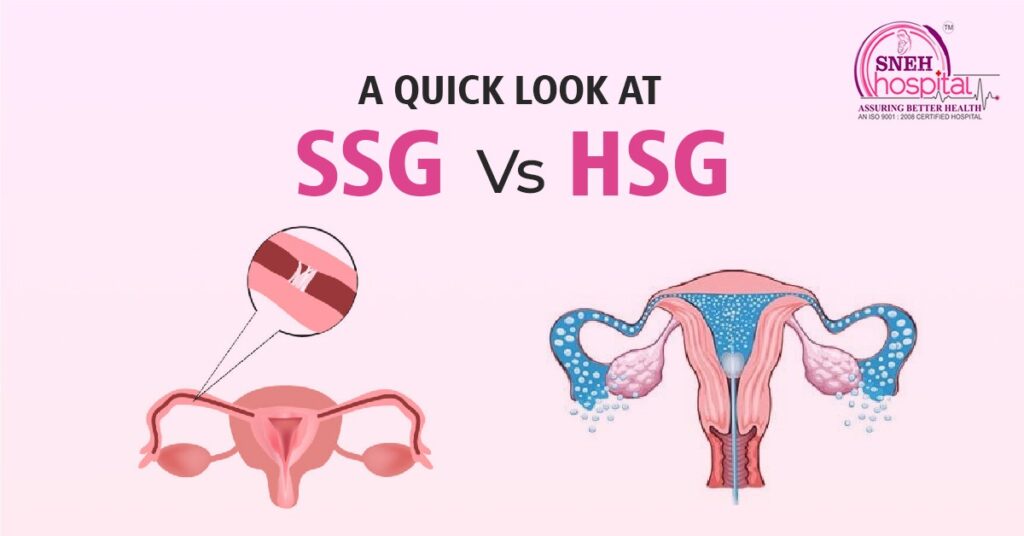When it comes to the realm of fertility, modern medicine has made significant advancements in diagnosing and treating various reproductive challenges. In the pursuit of parenthood, individuals and couples often seek clarity and insight into their fertility health.
In this blog post, we will delve into two important diagnostic procedures: SSG and HSG. These procedures offer valuable insights into the health and functionality of the female reproductive system, providing a comprehensive assessment of fertility potential.
Sonosalpingography (SSG):
The Sonosalpingography test, which is performed as part of an infertility examination when you are experiencing infertility, uses ultrasound to assess the fallopian tube’s patency. The doctor examines the tube for blockages or other abnormalities before beginning any reproductive treatments to try to conceive. It is crucial to clear obstructions from your tubes because failing to do so will prevent you from becoming pregnant.
Process of Sonosalpingography:
Sonosalpingography is a relatively safe, painless, and non-invasive procedure that requires neither sedation nor anesthesia to be carried out. Typically, this process takes 10 to 15 minutes.
Remember that this test won’t be done during your menstrual cycle; rather, it will take place 7-8 days following your menses. Although there are no radiations used in this test, some women may find it to be a little uncomfortable. The doctor will nevertheless give some medication to ease cramping and pain.
Saline sonosalpingography can check both uterus and fallopian tubes at the same time. To gain a proper and unobstructed image of the uterus’ interior, some saline will be injected into the uterus. A doctor will carry out this procedure while using ultrasound. After two to three hours of rest, you will be released after which you can resume your regular activities. Any anomalies and obstructions in the tube will be detected by this test.
Hysterosalpingography (HSG):
Hysterosalpingography is a kind of X-ray that examines the shape of the uterus and the patency of the fallopian tube to check whether there is any blockage or damage in the fallopian tube. In other words, this is uterosalpingography. This X-ray shows up the view in video instead of a still picture and this kind of X-ray is known as fluoroscopy. The doctor will fill your uterus and fallopian tube with contrast material to get a clear view. It is also used to detect the reason behind radiation tumors and repeated miscarriages. A small dose of ionizing radiation tumors is used to produce a clear picture of inside your body.
What it looks for and How it works?
This test is used to look for structural abnormalities in the uterus, uterine fibroids, polyps, tumors, and undesirable tissues in the uterus, and to determine whether surgery to reverse tubal ligation was effective. Fallopian tube obstructions, injury, adhesions, etc.
Most HSG procedures are carried out during the first half of the menstrual cycle. A device called a “speculum” will be put into the vagina to allow for a clear view of the cervix, and a local anesthetic will then be given for pain reduction at the end of the cervix. This procedure could be somewhat unpleasant. Water-soluble contrast material, which contains dye to enable clear X-ray vision, must be injected into the uterus during HSG.
The fallopian tube and uterus’ borders in terms of size and form are revealed by the dye. Mild cramps could be brought on by the liquids. To find the obstruction, you will need to move about. If the fluid moves slowly to the end, there is no obstruction. The body will eventually completely absorb the fluid. This gives the X-ray technician a proper or clear image of what’s within your body.
Both examinations aid in determining whether there are fallopian tube obstructions or uterine cavities. Your doctor will advise you to get the test based on your circumstances. These tests enable doctors to determine the cause of your infertility and the reason you are unable to conceive. After that, don’t hesitate to consult with one of our fertility professionals for advice. They have years and years of experience. Keep in touch!


